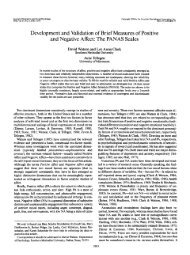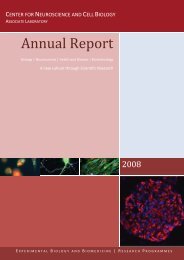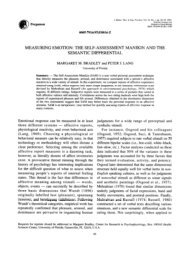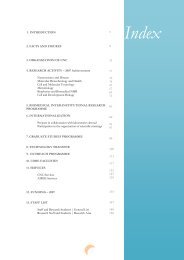Annual Report of Activities CNC 2011 - Center for Neuroscience and ...
Annual Report of Activities CNC 2011 - Center for Neuroscience and ...
Annual Report of Activities CNC 2011 - Center for Neuroscience and ...
You also want an ePaper? Increase the reach of your titles
YUMPU automatically turns print PDFs into web optimized ePapers that Google loves.
explain the <strong>for</strong>mation <strong>of</strong> all products from linoleic acid autoxidation hitherto detected in experiments in vitro under mild conditions, except <strong>for</strong> pyranosic <strong>and</strong> furanosic products, which we are currently addressing. Applying graph theoretical algorithms we could then trace minimal pathways to each product. Some <strong>of</strong> these pathways are more plausible than those proposed in the literature. Finally, we selected potential markers <strong>for</strong> the occurrence <strong>of</strong> specific scission mechanisms in vivo [Saravanan, Piñeiro & Salvador, manuscript in preparation]. Why do human erythrocytes use both catalase (Cat) <strong>and</strong> peroxiredoxin (Prx2) to defend against H 2 O 2 ? Our kinetic modeling [Benfeitas, Antunes, Salvador, in preparation] indicates that Cat <strong>and</strong> Prx2 complement each other in the defense against H 2 O 2 as follows. Under low/mild oxidative stress Prx2 is the main H 2 O 2 scavenger. However, the flux capacity <strong>of</strong> the Prx2 system is limited to ~0.23 µM H 2 O 2 /s. For higher H 2 O 2 influx Cat gradually becomes the main H 2 O 2 scavenger. Thus, Cat is necessary as a backup defense at high oxidative loads. But why don’t erythrocytes rely solely on Cat <strong>for</strong> H 2 O 2 elimination, thus sparing reducing equivalents? Fully replacing Prx2 such that the same [H 2 O 2 ] as in normal erythrocytes would be retained would require a Cat amount corresponding to ~32% <strong>of</strong> the hemoglobin contents. In turn, Prx2, with its higher specific second-‐order rate constant, accomplishes the same at an amount corresponding to just 1.7 % <strong>of</strong> hemoglobin contents. Thus, reliance on both Cat <strong>and</strong> Prx2 resolves a trade-‐<strong>of</strong>f between space <strong>and</strong> operation costs. Namely, by combining both defenses erythrocytes achieve effective protection over the whole physiological range <strong>of</strong> H 2 O 2 loads at both modest protein allocation <strong>and</strong> limited NADPH expenditure. 40






